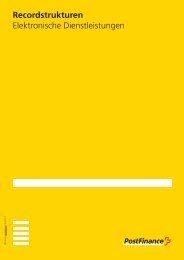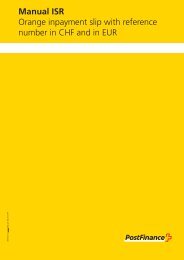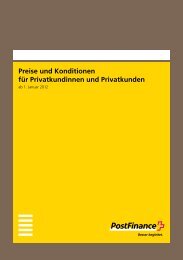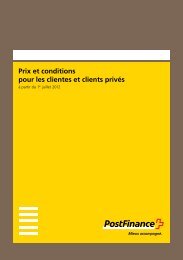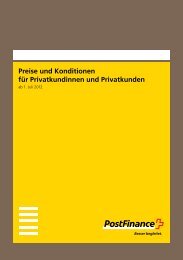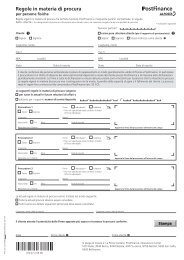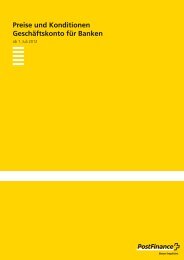Manual E-bill 499.41
Manual E-bill 499.41
Manual E-bill 499.41
Create successful ePaper yourself
Turn your PDF publications into a flip-book with our unique Google optimized e-Paper software.
8. Bill presentment module<br />
If the <strong>bill</strong> presentment module is used (see section 4.3.1) there are two<br />
possible options:<br />
• The <strong>bill</strong>er creates a PDF file for each <strong>bill</strong> from the <strong>bill</strong> detail data and<br />
transmits these to PostFinance (see section 8.1).<br />
• PostFinance creates a PDF for each submitted <strong>bill</strong> data using a standard<br />
style sheet (see section 8.2).<br />
There is always a 1:1 relationship between the <strong>bill</strong> data and the <strong>bill</strong> details.<br />
To show the same <strong>bill</strong> detail for several <strong>bill</strong>s, the static <strong>bill</strong> detail must be<br />
used (see section 4.3.4).<br />
8.1 Delivery of <strong>bill</strong> details by the <strong>bill</strong>er<br />
The <strong>bill</strong>er can design the layout of the PDF files as he wishes. In accordance<br />
with the security requirements of e-finance, they may not contain any hyperlinks<br />
except a secure link (URL in the format https:/ /w ww.yourcompany.<br />
ch/...) to a <strong>bill</strong> enclosure located on the <strong>bill</strong>er’s own platform. Furthermore,<br />
no active elements, e. g. Java Script, ActiveX or other links may be contained<br />
in them.<br />
To ensure optimum performance for the <strong>bill</strong> recipient, PostFinance recommends<br />
that the individual PDF files should not exceed 50 KB. The maximum<br />
size is 150 KB in order to avoid transmission problems.<br />
PDF files are assigned to the <strong>bill</strong> data via the BillerID and the TransactionID<br />
which together form a unique <strong>bill</strong> identifier. Thus the naming convention<br />
for PDF files is as follows:<br />
_.PDF<br />
Because PostFinance cannot check whether the details in the <strong>bill</strong> data<br />
correspond to those of the PDF file, it is the <strong>bill</strong>er’s responsibility to ensure<br />
the correctness of the PDF file and to adhere to this naming convention.<br />
The PDF files may be delivered separately or they may be integrated<br />
as a referenced object as a Base64 string with MimeType=x-application/<br />
pdfappendix into the “Appendix” element in the yellow<strong>bill</strong> invoice.<br />
If the PDF files are delivered separately, the order in which they are delivered<br />
makes no difference. Ideally, however, all <strong>bill</strong>s and their corresponding<br />
PDF files should be delivered on the same day. For further details concerning<br />
data delivery, please refer to section 11.<br />
8.2 Generating <strong>bill</strong> details via PostFinance<br />
The <strong>bill</strong> details in the yellow<strong>bill</strong> system are created exclusively by means<br />
of a standard style sheet. They contain the information required by law<br />
(incl. the addresses of the <strong>bill</strong>er and <strong>bill</strong> recipient, VAT number of the <strong>bill</strong>er,<br />
<strong>bill</strong> items, summary for each VAT set, etc.) but do not include the <strong>bill</strong>er’s<br />
logo. It is not possible to make individual adjustments to the style sheet.<br />
<strong>Manual</strong> E-<strong>bill</strong> Version October 2010 31/64



